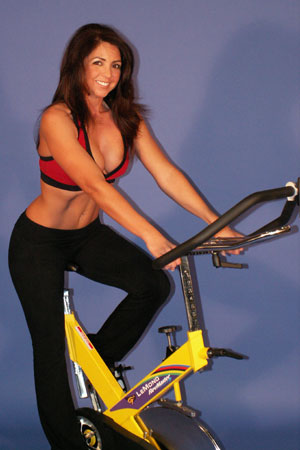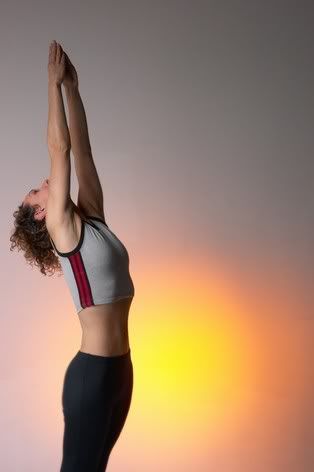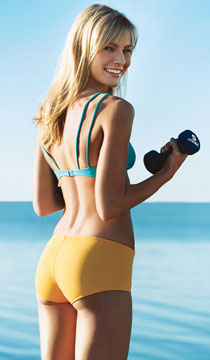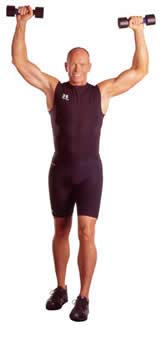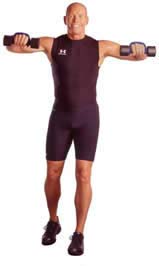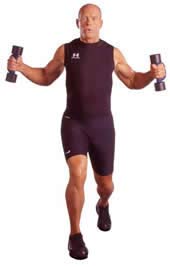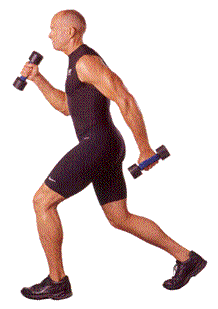
Exercise: Mind-Body Connection
Exercise not only makes you healthier, it also may make you more intelligent.
New research shows that in addition to causing the release of chemicals called endorphins — well-documented as the source of the "runner's high" — exercise may contribute to the formation of new connections among nerve cells in the brain and even to the growth of new cells. Other research has underscored the strong correlation between exercise and higher mental function.
It's possible that running, cycling and other sports may trigger a primal "flight or fight" response in us, and in doing so, may spur brain cell growth, much as it did in ancient hunters as they chased their prey or were chased by predators. Or it could just be that getting more blood to the brain is good for us.
Experts caution that no one knows what these new cells actually do in the human brain, or whether they really become part of functional circuits that affect behavior and thought. But what is no longer in doubt is that new cell growth has been found in the places in the brain where we think, learn and remember.
Not long ago, neuroscientists believed the brain stopped producing any new nerve cells, called neurons, at birth. Researchers knew that synapses, the connections between neurons needed for transmitting memories and thoughts, change and grow as a person ages, declining later in life. But their consensus was that the number of neurons had only one way to go: down.
During the past few years, researchers at institutions in the United States and abroad have turned that thinking on its head as they pioneered the study of neurogenesis, or new brain cell development. They have found in a number of test subjects, including humans, that neurons are continuously being formed, even by the elderly. And behavior has a significant impact on how many new cells are grown. The results are astonishing.
"The surprise is that the rate at which new cells are being born in the brain are regulated by, among other things, your interaction with your environment," neurobiologist Fred H. Gage says. And exercise seems to be a key to that interaction.
"One of the things that happens with exercise is an increase in the micro blood vessels in the brain," he says. Those blood vessels are associated with the birth of new cells. "So there is a physiological link between exercise and neurogenesis," he says.
When you exercise, muscles begin to use oxygen at a higher rate, and the heart pumps more oxygenated blood through the carotid artery to the brain. In fact, the brain uses about 25 percent of the oxygen that you take in. Because exercise creates endorphins, people who exercise regularly have more energy, feel alert and have an increased sense of well-being and better memory retention.
Prior to the recent studies, scientists assumed that increased cerebral blood flow was the factor linking exercise and better brain function. Now, we are beginning to understand more about the workout-brain connection.
In The Laboratory
In 1998, Gage of the Salk Institute and Peter Eriksson at the Sahlgrenska University Hospital in Göteborg, Sweden, studied hippocampal tissue in deceased cancer victims ranging in age from 57 to 72 years old at death. Each patient while living had received an injection of bromodeoxyuridine, or BrdU, for diagnostic purposes.
BrdU is absorbed only by cells that are dividing, meaning they are creating new cells. In cancer patients it is used to see if cancer cells are multiplying. When BrdU-labeled neurons were found in the hippocampus, it was a the equivalent of a smoking gun for Gage and Eriksson. They could only conclude that neurogenesis was taking place.
"The way you detect new neurons is in part by determining whether or not they're undergoing cell division," Gage says. More important, these new cells weren't just floating around aimlessly.
"We found these new neurons were known and recognized by the other cells.
And they looked as though they're wired up to the appropriate area" to potentially play a role in cognition.
Meanwhile, Gage and other Salk scientists were engaged in different research, this time on the effects of learning on the brains of mice. What they found could have big meaning for us humans. The mice were exposed to a rich environment of toys, treats and other incentives to think.
Almost as an afterthought, running wheels — mouse treadmills — were introduced as another variable. The mice ran at their own pace, as often and for as long as they liked. And the mice that did the running grew twice the new brain cells as mice in a control group.
The Salk researchers do not know why running should have such an enhancing effect on neural development. There are some informed guesses: Running might increase the flow of oxygen and nutrients to brain tissues or release special growth factors that promote new neurons, Gage said. Or it could be that running prompts the nervous system to prepare for an onslaught of new information as an animal navigates unfamiliar terrain in the pursuit of prey or in flight from an enemy.
Meanwhile, at Princeton, neuroscientists Elizabeth Gould and Charles Gross of the university's psychology department brought neurogenesis a step further, finding new neurons not just in the hippocampus of adult rhesus monkeys but also in the more advanced cerebral cortex.
In order to test for the presence of new neurons in the adult brain, Gould and Gross injected the monkeys with BrdU. At different times after the injection, ranging from two hours to seven days, the researchers examined the cerebral cortex and found evidence of BrdU in cells in three different regions, all of which play a role in higher thought.
The researchers were able to detect several different proteins in the cells that are found specifically in neurons. Also, they showed that the cells containing BrdU had the long axon extensions characteristic of neurons.
To get those results, Gould and Gross used a technique called fluorescent retrograde tracing. In this technique a chemical dye is applied to a small region of the brain, and the dye travels from the end of an axon back to the cell body, making the axon visible under a microscope.
And when the monkeys engaged in various stimulating exercises, the number of new cells jumped.
Taken together these recent findings suggest that neurogenesis is found across the range of mammalian species, including human beings.
Gould and Gross reiterate that it's not yet known what purpose the new cells serve in the cortex, but if the newly formed neurons are found to have a functional role, scientists may have to reexamine current theories about how the brain works.
In the not-too-distant future, Gage says, advanced brain imaging techniques will probably show how exercise, both physical and mental, causes new neural development in humans. What we already know, he says, is that the brain is not a one-way street where it simply controls our behavior.
"We are finding that the behaviors that people engage in in return have an effect on the underlying structure of the brain and on the number of cells and how they're wired in the brain, which then will subsequently have an affect on what your next behavior is going to be."
Even clearer proof that the human brain benefits from aerobic exercise was found in a study at the University of Illinois' Beckman Institute for Advanced Science and Technology. Its study, funded by the National Institute on Aging, examined the cognitive impact of walking or doing toning exercises on 124 adults ranging in age from 60 to 75.
Participants in both exercise groups showed improvement doing a repetitive task, such as pushing a button, when given a visual cue. However, the walkers were better able to process and ignore irrelevant cues and successfully complete tasks than were those who had done only toning exercises.
Processing relevant information and discarding distractions are essential to "executive control," a term that covers such things as planning, inhibition and temporarily maintaining information in memory.
"Executive control processes are largely controlled by the frontal and prefrontal regions of the brain, areas which show negative metabolic and morphological changes during the normal aging process," says Arthur F. Kramer, a psychologist and researcher at the Beckman Institute. "Cells shrink and blood flow decreases. The benefits you get from walking are in the varieties of cognition that show the largest age-related decline."
Brain Workout
WorldThe question we are left with is, what should we do to stimulate our personal cognitive development, and when do we know it's working? When you do sit-ups, you expect to develop killer abs. We know that when we run or bike for an hour, we feel either exhausted or invigorated by an endorphin rush. But that wears off quickly. How do we know we are doing enough to help the brain muscle?
And if running is so good, what about sports that also involve more thinking, more teamwork, the kind of social interaction that psychologists have long linked with better mental health of the psychologic kind?
The answers will be a long time coming, but there are some theories, at least. "Social stimulus is often quite effective" in neurofunctioning, says Gage, who thinks other sports that involve social interaction may have advantages for neurogenesis, as long as they are aerobic.
"Scientists tend to use running or walking experimentally because they can isolate it and talk about it and say yes, independent of social interaction, independent of any learning experience, independent of any other variables, just exercise alone is adequate," he says. "It doesn't mean that there aren't many other ways that you can go to get there."
The bottom line is, until we know better, it is best to keep running, or start an exercise program that gets the blood pumping. It's good for mind, body and soul.
Neurobics
Running, biking and playing tennis get blood flowing to the brain, but sweating isn't the only way to get and stay smart, neuroscientists believe.
The mind needs to play internal games as well to stay sharp, says Dr. Amir Soas, of the Case Western Reserve University Medical School in Cleveland. "If there are areas in the brain that you totally don't use or that remain unused over a long period of time, they have a tendency to deteriorate like anything else in your body," he says.
The more complex the task, the more synapses are firing in more parts of the brain. Just as you would build new blood vessels in your quadriceps muscles in your legs, you need mind workouts to keep the network of blood vessels in the working parts of the brain growing and healthy. Research indicates this can even stave off Alzheimer's and Parkinson's diseases in people likely to develop those afflictions.
Activities like writing a short story, learning to play chess or a new language, or even doing a crossword puzzle involve more than one thing, using more of your brain, so a greater number of synapses are working simultaneously

